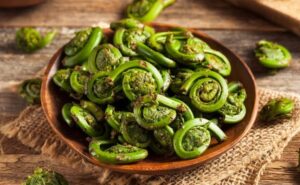Table of Contents
The Nutritional Power of Fiddlehead Ferns and Health Benefits
What Are Fiddleheads?
When May arrives, it’s time to enjoy the coiled tips of the ostrich fern, known as fiddleheads, which offer a distinctive earthy, nutty flavor. Fiddleheads are the young shoots of the ostrich fern (Matteuccia struthiopteris), harvested in the early spring season.
Fiddleheads are popular in many regions, particularly along the East Coast of the United States and in Canada, where foragers eagerly await their short harvesting season. They are typically available from mid-April to early May. Although you can find fiddleheads at specialty food markets, they are often foraged due to their brief availability.

The Nutritional Power of Fiddlehead Ferns and Health Benefits
The Appeal of Fiddleheads
So, what’s the big deal with fiddleheads? For one, they have a distinct, crisp, and fresh flavor, which many compare to a combination of asparagus and spinach. But more importantly, their nutrient profile is impressive, offering an excellent source of antioxidants, omega-3 fatty acids, and vitamins.
Fiddlehead Fern Nutrition: A Superfood in Disguise
While fiddleheads are not as commonly known as other vegetables, their nutritional content sets them apart. According to the U.S. Department of Agriculture, a one-ounce serving (28 grams) of raw fiddleheads contains the following nutrients:
- 9.5 calories
- 1.6 grams carbohydrates
- 1.3 grams protein
- 0.1 gram fat
- 1,013 international units (IU) of vitamin A (20% DV)
- 7.4 milligrams of vitamin C (12% DV)
- 1.4 milligrams of niacin (7% DV)
- 0.1 milligrams manganese (7% DV)
- 0.1 milligram copper (4% DV)
- 0.1 milligram riboflavin (3% DV)
- 104 milligrams potassium (3% DV)
- 28 milligrams phosphorus (3% DV)
- 0.4 milligrams iron (2% DV)
- 9.5 milligrams magnesium (2% DV)
- 0.2 milligrams zinc (2% DV)
Health Benefits of Fiddleheads
1. A Powerful Source of Vitamin A
Vitamin A is known for its role in promoting healthy skin, vision, and immunity. It also acts as a potent antioxidant, reducing free radicals that contribute to DNA damage. A single ounce of fiddleheads provides over 20% of the daily recommended value of vitamin A. This makes fiddleheads an excellent source of disease-fighting and anti-aging nutrients.
2. Rich in Vitamin C
Vitamin C is another antioxidant powerhouse, contributing to immune support and reducing inflammation. Higher intakes of vitamin C-rich foods, such as fiddleheads, have been linked to a reduced risk of chronic conditions, making them an excellent addition to your diet.
3. Boosts Energy with Niacin
Niacin, a B vitamin found in fiddleheads, plays an essential role in converting food into energy. It also supports brain, skin, and heart health, and may even help prevent neurodegenerative diseases like Alzheimer’s. Including niacin-rich foods in your diet can be a step toward maintaining overall wellness.
4. Low-Calorie Option for Weight Control
With only 9.5 calories per ounce, fiddleheads make a nutrient-dense, low-calorie snack or side dish. They help fill you up without adding significant calories, making them an excellent choice for those aiming to maintain or lose weight.
5. Anti-Inflammatory and Antioxidant Benefits
Fiddleheads are not just low in calories; they are also packed with antioxidants and anti-inflammatory compounds. This makes them a great addition to meals aimed at reducing inflammation, boosting energy, and improving overall health.
How to Cook Fiddleheads
Cooking fiddleheads is simple. You can easily sauté, steam, or boil them. Here are the steps to properly prepare fiddleheads:
- Rinse thoroughly to remove dirt and grit.
- Lightly cook them—boiling for 6–8 minutes or sautéing in butter or olive oil are great options.
- Season with salt, pepper, and lemon juice for enhanced flavor.
Fiddleheads can be used in salads, stir-fries, soups, and as a side dish. Their unique, grassy flavor makes them a delightful addition to various recipes.
Recipe Idea: Sautéed Fiddleheads
This simple sautéed fiddlehead recipe highlights their natural flavor. Here’s how to prepare it:
- 2–3 cups washed and trimmed fiddlehead ferns
- 3 tablespoons extra-virgin olive oil
- 1 clove minced garlic
- ½ teaspoon salt and pepper
- Lemon juice for garnish
Heat olive oil in a skillet, add garlic, salt, and pepper. Sauté fiddleheads for 7–10 minutes on low heat. Remove from heat and finish with a squeeze of lemon juice. Optionally, blanch the fiddleheads in boiling water for one minute before sautéing to reduce bitterness.
Risks and Side Effects
Though fiddleheads are nutritious, care must be taken when foraging or consuming them. Only the shoots of the ostrich fern should be eaten, as other types of ferns can be toxic. Furthermore, always cook fiddleheads before consuming them, as eating them raw may result in stomach discomfort due to potential bacterial contamination.
Conclusion: Why You Should Add Fiddleheads to Your Diet
Fiddleheads are a seasonal delicacy packed with vitamins, antioxidants, and anti-inflammatory compounds. Whether you’re looking to boost your immunity, promote healthy aging, or add variety to your meals, these young fern shoots are a great choice.
For more information on the benefits of incorporating nutrient-dense vegetables into your diet, check out this article from WebMD.
Learn more about foraging practices from Nature’s comprehensive guide.
Discover additional health benefits of incorporating vitamin-rich foods into your diet at Healthline.